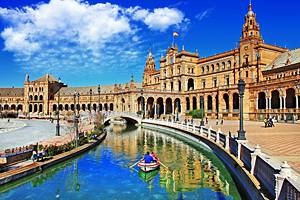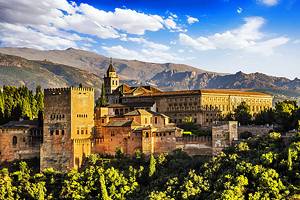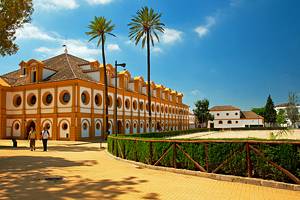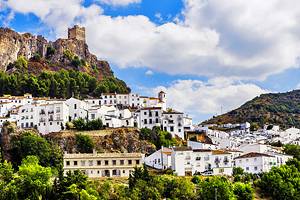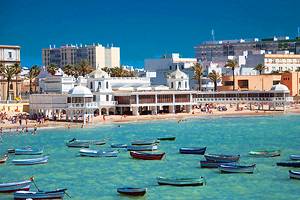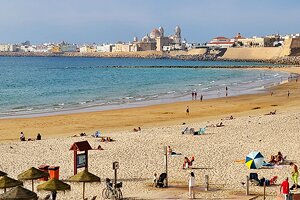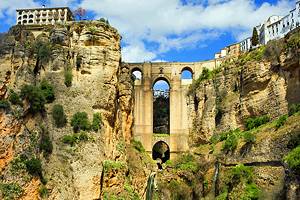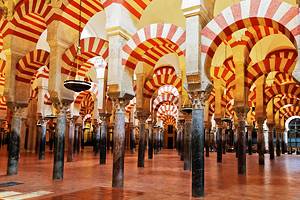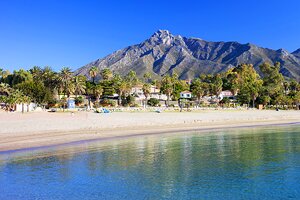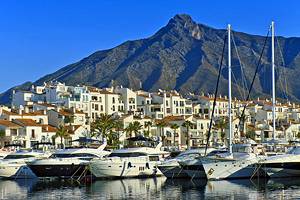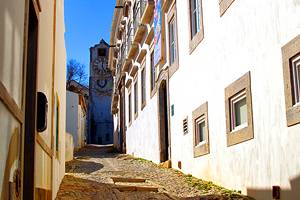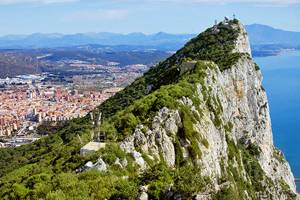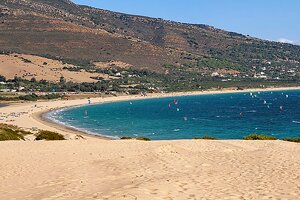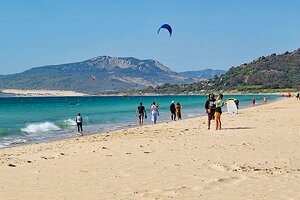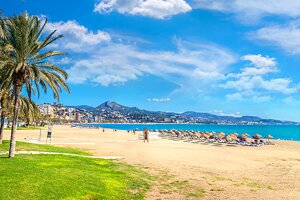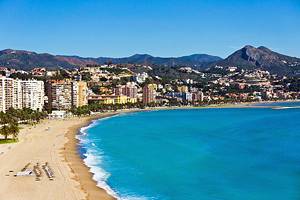Tourist Attractions in Seville
Author Michael Law spent a week soaking up the sights of Seville.
From the minute you step foot on the quaint cobblestone lanes and stroll the palm-lined promenades of Seville, you'll be enchanted. Elegant edifices, old-fashioned street lamps, and horse-drawn carriages create a magical ambience, and the sights are as stunning as the famous flamenco performances and flamboyant festivals.
The city boasts the largest Gothic church in Christendom with a majestic tower that was once the minaret of a great mosque. Another relic of the Moorish past, the Alcázar dazzles with its lavish Mudéjar decor and lush gardens.
The charm of this quintessential Andalusian city is found in the quiet courtyards and winding alleyways of the medieval Barrio de Santa Cruz, as well as in the beautiful open spaces of the Parque de María Luisa and the Plaza de España, Seville's most graceful square.
Brimming with cultural attractions, Seville is a gem of Southern Spain's Andalusia region. Find the best places to visit with our list of the top attractions and things to do in Seville.
- Catedral de Sevilla
- Real Alcázar
- Plaza de España
- Parque de María Luisa
- Barrio de Santa Cruz: Seville's Most Charming Neighborhood
- Museo de Bellas Artes
- Iglesia Colegial del Divino Salvador
- Santa Semana (Holy Week Festival)
- Museo del Baile Flamenco (Museum of Flamenco Dance)
- Real Maestranza de Caballería de Sevilla
- Barrio de Triana
- Casa de Pilatos
- Museo Arqueológico de Sevilla
- Ayuntamiento de Sevilla (Town Hall)
- Palacio de la Condesa de Lebrija
- Monasterio de Santa Paula
- Archivo General de Indias
- Torre del Oro
- Metropol Parasol
- Seville's Riverfront
- Map of Tourist Attractions & Things to Do in Seville
Catedral de Sevilla

The Catedral de Sevilla makes an unforgettable impression. As the world's largest Gothic cathedral, this monument is unmatched in its impressive scale and abundance of art treasures. Listed as a UNESCO World Heritage Site, this glorious place of worship was constructed between 1402 and 1506 on the site of the town's principal mosque.
The cathedral's bell tower, La Giralda, was originally the minaret of the mosque built in the 12th century by Moorish rulers of the Almohad dynasty. This 93-meter-high tower is still the emblem of Seville.
Entering the cathedral, visitors are surprised by the immense proportions of the nave. The five-aisled interior extends 117 meters in length and 76 meters across and soars to 40 meters in height. This overwhelming space is the most grandiose Gothic interior in Spain.

The Capilla Mayor (Main Chapel) features a resplendent retablo, considered a masterpiece of Gothic woodcarving. In the center is an image of the Virgen de la Sede surrounded by 45 scenes from the Life of Christ and the Life of the Virgin. In the south transept stands a striking monument to Christopher Columbus, fitting of his historic stature.
Behind the Capilla Mayor is the Capilla Real (Royal Chapel). Built between 1551 and 1575, this domed Renaissance chapel contains the royal tombs.
The Sacristía Mayor is a magnificent 16th-century chamber, which contains a large candelabrum and a crucifix by Pieter de Kempeneer. Within the Sacristía Mayor, the Treasury displays the precious gem-adorned crown of the Virgen de los Reyes.
A notable feature of the Cathedral's architecture is the Patio de los Naranjos (Patio of Orange Trees), which was the forecourt of the mosque. The octagonal fountain in the center is a remnant of the fountain used by worshipers for religious ablutions in Moorish times.
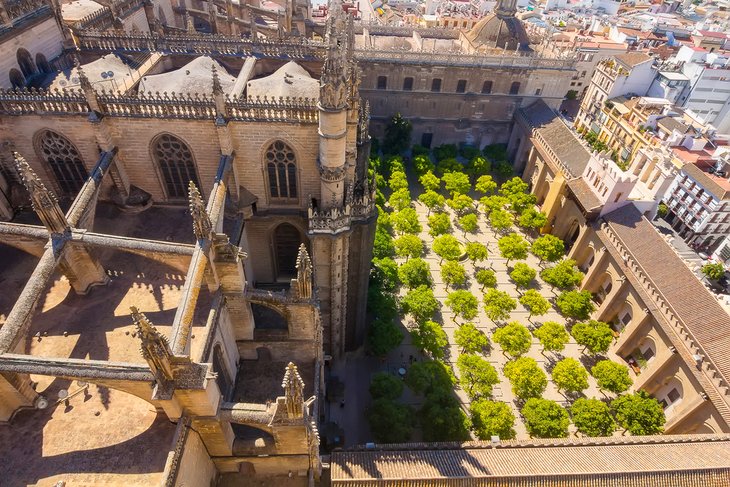
On the east side of the Patio de los Naranjos is the Biblioteca Colombina. The son of Christopher Columbus, Hernando Colón, put together the collection for this library between 1496 and 1539, and it is one of the most important collections of Renaissance-era volumes in Spain, with a special focus on the humanist writings of the Golden Age.
For a break from sightseeing after visiting the cathedral, head to the Calle Sierpes, north of the Plaza Nueva. This narrow pedestrian lane is Seville's main shopping street, lined with shops, cafés, and restaurants.
One of the most popular café-restaurants in Seville, Robles Laredo, is tucked away at the end of the Calle Sierpes on the Plaza de San Francisco. This lively restaurant specializes in tapas and other Andalusian cuisine. Tourists can opt for the restaurant's outdoor terrace seating to soak up the ambience of Seville.
On the other end of Calle Sierpes, the Confitería La Campana tempts customers with its enticing Andalusian confections. This artisanal pastry shop has been selling handmade cakes, cookies, chocolates, and other sweets since 1885. The selection ranges from Tortas de Polvorón, traditional cinnamon- and anise-spiced biscuits made in Seville, and Yemas Sevillanas (another local specialty), sugar-coated custard-like mini cakes, to cream puffs; chocolates; and candied figs, oranges, and pears.
Address: Catedral de Seville, Plaza del Triunfo, Avenida de la Constitución, Sevilla
Real Alcázar
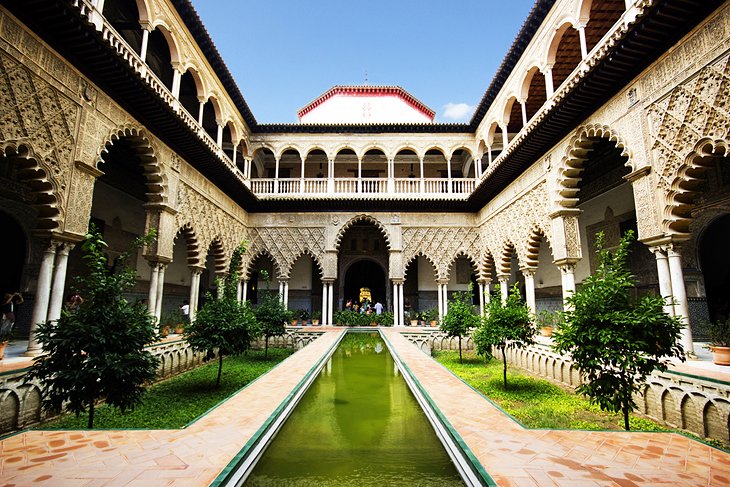
The Real Alcázar invites travelers to step into another world, an exotic place sure to inspire the imagination. Fascinating history and a breathtaking interior decor await visitors.
This UNESCO World Heritage Site was built as a fortress in the 10th century for the Caliph of Cordoba. In the 11th century, the Alcázar was the seat of the legendary Moorish ruler and poet al-Mu'tamid. Subsequent Moorish rulers expanded the site and added to the group of buildings.
After the Christian Reconquest, the palace was renovated in Mudéjar style (a blend of Gothic details and Arabic elements) for Pedro I in the 14th century. Elaborate embellishments throughout the palace, such as colorful tile floors (azulejos) and patterned walls and ceilings, reveal the fanciful new architectural aesthetic.
Visitors enter the Real Alcázar through the Puerta Principal, which leads to the Patio de las Doncellas (Maidens' Courtyard). This elegant courtyard was built between 1369 and 1379 and exemplifies Islamic architecture, with magnificent arches featuring open arabesque designs above 52 marble columns.
The throne room of Pedro I, the Salón de Embajadores (Hall of the Ambassadors) has a splendid domed ceiling, with decorative friezes and inscriptions in Arabic script.
Off the Patio del León (The Lion Courtyard) is the Sala de Audiencias (Chapter House), one of the most exquisitely adorned rooms in the palace, featuring a 16th-century artesonado (intricately carved wood) ceiling. The Sala de Audiencias contains a noteworthy gilded triptych on its altar titled Virgen de los Mareantes (Virgin of the Seafarers) by Alejo Fernández.
Also not to be missed are the beautifully manicured grounds, Los Jardines del Alcázar. The gardens are planted with leafy palms, fragrant orange trees, and vibrant roses. In traditional Andalusian style, patios, ornamental pools, and refreshing fountains define the landscaping. Adding to the dreamy quality, an ostentation of peacocks wanders this luxuriant outdoor space.
The Alcázar gardens and the Salón de Embajadores were used as a film set for the Game of Thrones series. Fans of the show will recognize the fountain-filled gardens as the Kingdom of Dorne's Water Gardens. Cinema buffs will also discover the Palace of the Kingdom of Naboo from Star Wars, as well as the setting for some of the scenes in Lawrence of Arabia.
The Spanish royal family still uses the upper level of the Real Alcázar as an official royal residence in Seville. The Real Alcázar has the distinction of being the oldest royal palace in Europe that is still in use.
Address: Patio de Banderas, Sevilla
Official site: https://www.alcazarsevilla.org/en/
Plaza de España
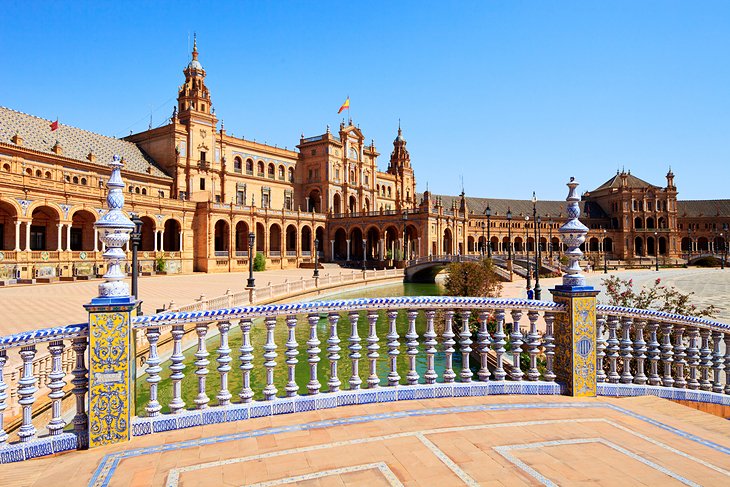
Inside the Parque de María Luisa, the Plaza de España dazzles visitors with its scale and grandeur. The enormous 50,000-square-meter plaza is surrounded by the balustraded balconies of a Neo-Moorish building, which curves around following the shape of the canal running through the square.
A monumental fountain graces the center of the square, while the peaceful canal is crossed by four footbridges. Tourists can rent a rowboat for the afternoon to experience the "Venice of Seville" or opt for an equally romantic horse-drawn carriage ride through the park.
The Plaza de España is frequently the site of open-air concerts and performances. The sight of the historical building lit up behind the stage at night is magical. Note that if a performance is scheduled, the entire area will be gated and inaccessible.
Address: Parque de María Luisa, Avenida de la Palmera, Sevilla
Parque de María Luisa
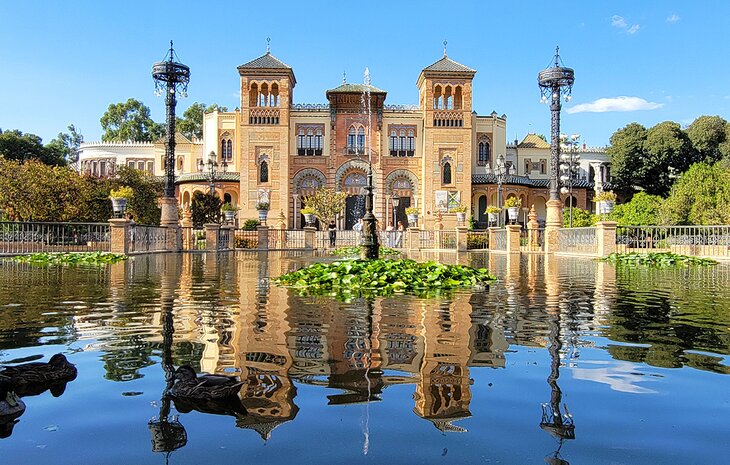
The Parque de María Luisa, with the Plaza de España at its center, was the site of the Exposición Iberoamericana in 1929. This expansive green space was created for the Infanta María Luisa Fernanda de Borbón, who donated it to the city of Seville in 1893.
The lush 34-hectare park flourishes alongside the river, with its exotic palms, orange trees, elms, and Mediterranean pines. The landscaping features bright flower beds, shady avenues, Moorish-style fountains decorated with colorful ceramic tiles, and ornamental pools. Park benches and pathways add to the inviting ambience.
The Archeological Museum and Museo Artes y Costumbres Populares are located at the far eastern end of the park across from one another. The building housing the Museo Artes y Costumbres Populares is spectacular, and a fine photo can be had by framing the duck pond and fountain in front.
Barrio de Santa Cruz: Seville's Most Charming Neighborhood

Found between the Catedral de Sevilla and the Real Alcázar, the Barrio de Santa Cruz is one of the most charming places to explore in Seville. It was the Judería (Jewish quarter) during the medieval era under Moorish rule, when many of the quarter's churches were originally synagogues.
Full of old-world atmosphere, this captivating medieval neighborhood is characterized by its labyrinth of cobblestone pedestrian lanes (too narrow for cars), whitewashed houses with attractive patios, and picturesque plazas with outdoor cafés.
Many of the quiet courtyards, such as the Plaza de Doña Elvira, are planted with fragrant orange trees. The Plaza de Santa Cruz features rose beds and a 17th-century wrought-iron cross in the center. At the Plaza de los Refinadores, visitors will find a statue of Don Juan Tenorio, a local literary character.
Two noteworthy museums are found in the Barrio de Santa Cruz: the Centro de Interpretación Judería de Sevilla (Calle Ximénez de Encisco 22A), which illustrates the history of the city's Sephardim (Spanish Jews) who lived in this quarter during the Middle Ages and until the Inquisition; and the Hospital de los Venerables (8 Plaza Venerables), a 17th-century hospital for retired priests, which now houses a collection of Spanish paintings and sculptures.
One of the special things to do in Seville is stroll through the Jardines de Murillo, beautiful gardens filled with palm trees, fountains, and tiled benches.
For an excellent view of the cathedral's La Giralda tower, head to the Patio de Banderas, a small square featuring a fountain and orange trees.
Museo de Bellas Artes
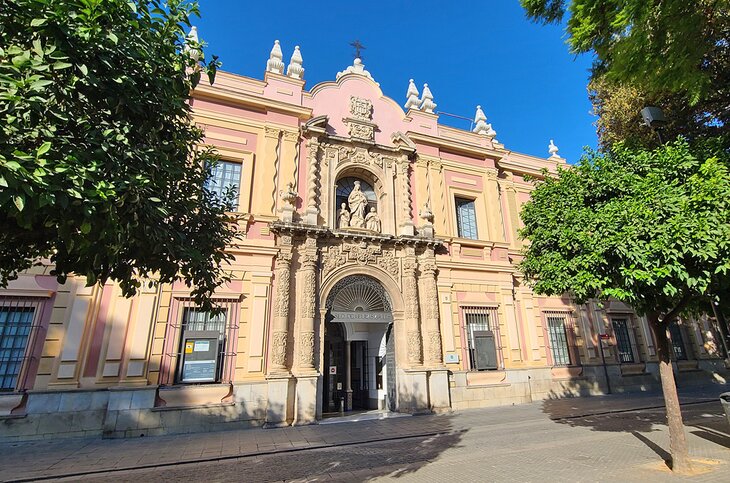
Seville has an exceptional Museum of Fine Arts, housed in the stately 17th-century Convento de la Merced Calzada. This museum is considered to have the best collection of paintings in Spain after the Prado in Madrid. The collection covers artworks from the Gothic period through the 20th century.
The representation of works by 17th-century Spanish painters is especially noteworthy. Visitors will see masterpieces by renowned Spanish artists including El Greco, Francisco Pacheco, Diego Velázquez, and Alonso Cano.
The museum has a special focus on masterpieces by Bartolomé Esteban Murillo, as well as works by the Seville school of the 17th century. The religious paintings by Francisco de Zurbarán are also excellent.
Tour the museum and then spend a bit of time on the delightful plaza located in front. Settle in with a coffee under the tall trees. The tinkling fountain and relaxed vibe tend to encourage lingering.
Address: 9 Plaza del Museo, Sevilla
Iglesia Colegial del Divino Salvador
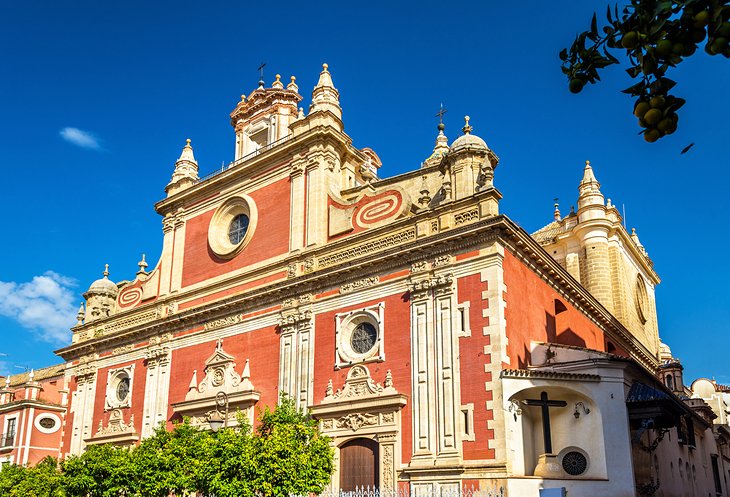
A short walk from the cathedral, the Iglesia Colegial del Divino Salvador is a stunningly beautiful Baroque church. Construction began in the late 17th century on the site where La Mezquita Aljama de Ibn Adabbás, Seville's old mosque once stood, and many additions have taken place since this time.
Glowing pink in the late afternoon light, the ornate facade is influenced by the Mannerist-style. Equally splendid and surprisingly grandiose, the extravagant gilded interior is a treasure trove of Sevillian Baroque details and lavish artwork.
Two spectacular altarpieces adorn the sanctuary: Sacred Christ of Love by Juan de Mesa and Jesus of the Passion by Juan Martínez Montañés. Other highlights are the soaring dome, the 18th-century organ, and the 16th-century Sacristy.
Like the cathedral, this lovely church also includes a courtyard with orange trees. The patio is a vestige of the original Moorish architecture.
Tip for Travelers: You can purchase a combined ticket here for Iglesia Colegial del Salvador and the Catedral de Sevilla, which allows you to skip the typically long lines at the cathedral.
Address: Plaza del Salvador, S/N, 41004 Sevilla
Santa Semana (Holy Week Festival)
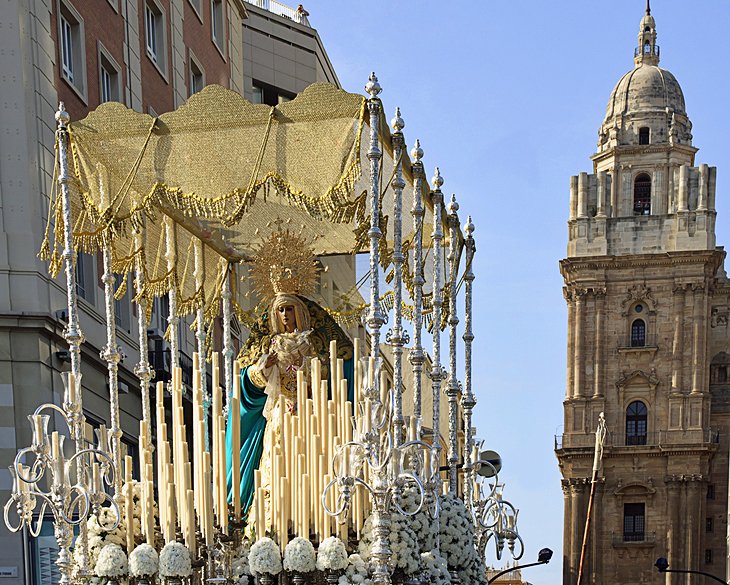
The Semana Santa celebration in Seville is one of the most exciting festivals in Spain. Following centuries-old traditions, the Catholic brotherhoods (cofradías and hermandades) from different quarters of town participate in elaborate processions. Clad in penitents' garb, they carry ornately decorated floats that display statues of saints.
The main procession is the eve of Good Friday and on Good Friday morning, and marvelous ceremonies are held in the cathedral during Holy Week.
During the rest of the year, visitors can still see the famous icon of the Holy Week procession at the Basílica Menor de la Santísima María de la Esperanza Macarena (1 Calle Bécquer). This church possesses the Virgen de la Esperanza, (also known as "La Macarena"), which makes a tour around town on a lavish float during Holy Week. With a tender expression and tears running down her cheeks, this Virgin figure evokes an emotional response.
Museo del Baile Flamenco (Museum of Flamenco Dance)
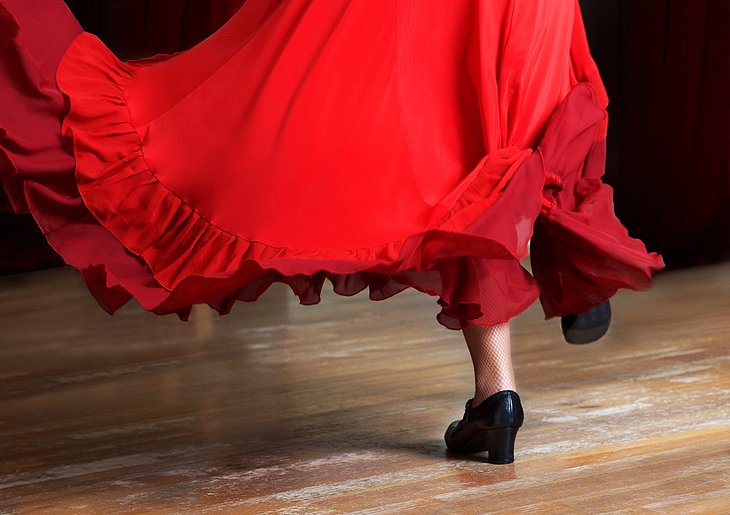
Seville is famous for its flamenco, a flamboyant art form with roots in the Gypsy culture. Flamenco includes both dancing and singing, but most importantly, it is an expression of the soul. The best flamenco dancers have technical prowess, as well as a special gift of channeling the emotions.
The Museo del Baile Flamenco celebrates the beauty of flamenco with exhibits on all aspects of the art: dancing, singing, and guitar. This innovative museum features flamenco costumes, creative video displays, and other educational exhibits.
The museum also has a Flamenco School and hosts professional Flamenco Performances daily year-round. The performances begin at 7pm and last for one hour.
Other places to see flamenco shows include El Palacio Andaluz (4 Calle Matemáticos Rey Pastor y Castro), a traditional tablao-style (small venue) theater near the Basílica de la Esperanza Macarena; the Tablao Flamenco Los Gallos (11 Plaza de Santa Cruz, in the Barrio de Santa Cruz), one of the oldest tablaos in Seville; and La Casa del Flamenco (28 Calle Ximénez de Enciso, also in the Barrio de Santa Cruz), where flamenco shows are presented in the courtyard of a 15th-century palace.
Flamenco shows are also held almost every night at La Carbonería on Calle Céspedes. It's a popular nightlife spot, so arrive early to score a seat.
Address: Museo del Baile Flamenco, 3 Calle de Manuel Rojas Marcos, Sevilla
Real Maestranza de Caballería de Sevilla
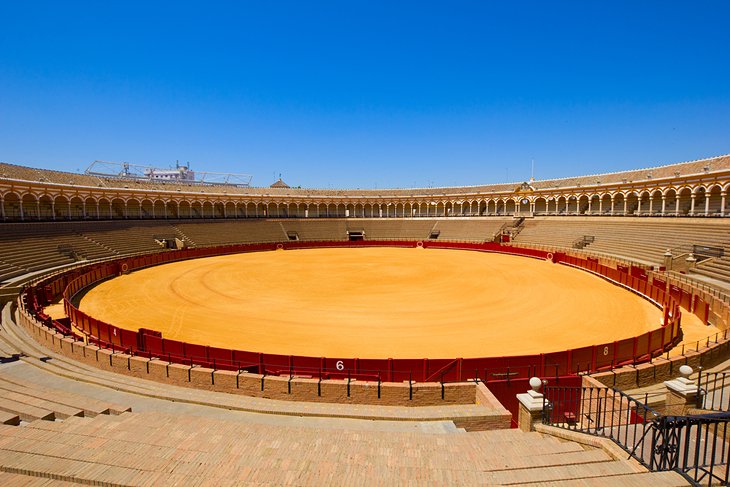
The Real Maestranza de Caballería de Sevilla (Royal Bullring of Seville) is one of the finest bullrings in Spain, and with seating for around 12,500 spectators, it is also one of the largest.
Built in 1761, the Royal Bullring is an emblematic landmark of Seville. The design is distinctly Baroque, with an oval-shaped ring that makes it unique among Spanish bullrings, and its graceful arcaded seating provides welcome shade on sunny days. A special box within the bullring, the Palco del Príncipe, is reserved for members of the Spanish royal family.
The Royal Bullring contains a museum with a collection of traditional matador costumes, as well as photographs and paintings related to the dramatic art of bullfighting. Highlights are the prints by Francisco de Goya and a painting titled Cogida de Muerte de Pepe Hillo by Eugenio Lucas Velázquez. A visit to the museum provides a glimpse into the fascinating heritage of bullfighting.
The tradition of bullfighting in Seville has its roots in a custom of medieval chivalry: The nobility trained in horsemanship and using weapons to be prepared for warfare. In 1670 during the reign of Carlos II, the Real Cuerpo de Maestranza de Caballería de Sevilla (Royal Corps of Cavalry) was founded to serve the Crown.
Visitors continue their tour by walking from the museum to the Patio de Caballos (Courtyard of the Horses), which leads to the Capilla de los Toreros (Bullfighters' Chapel). Matadors pray at this chapel before a fight and leave votive offerings at the Virgen del Rosario altarpiece.
Address: 12 Paseo de Colón, Sevilla
Barrio de Triana
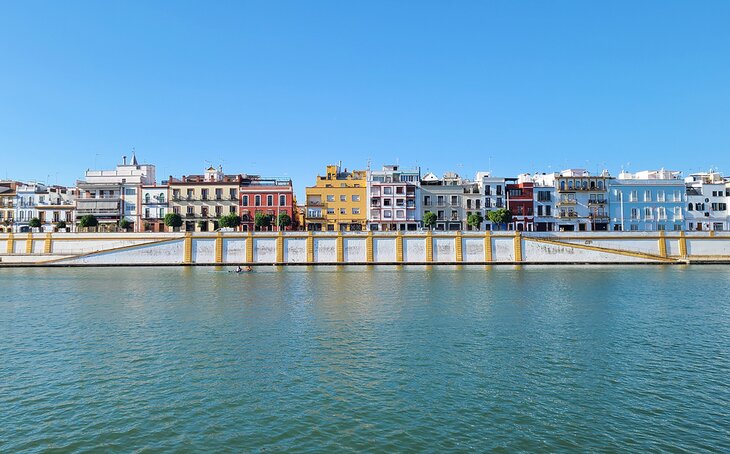
This historic quarter of Seville has its own distinct character and identity. Across the river from the main tourist attractions of Seville, the neighborhood has the ambience of being a world apart.
Similar to the Barrio de Santa Cruz, the Barrio de Triana is a maze of narrow cobblestone streets and alleyways leading to atmospheric squares.
What distinguishes the Barrio de Triana is its heritage as a traditional potters' quarter, as well as its Gypsy community. For centuries, the people of this neighborhood have used the clay from the banks of the Guadalquivir River to create authentic Andalusian ceramics.
The ceramic workshops and boutiques of the Barrio de Triana, mostly located on the Calle Callao, the Calle Antillano Campos, and the Calle Alfarería, are especially renowned for their fine azulejos, glazed ceramic tiles adorned with colorful geometric patterns–a legacy of Andalusia's Moorish aesthetic.
The boutiques of this quarter also sell beautiful decorative ceramic plates, cups, pitchers, serving pieces, and other objects for the home. After browsing the little shops, tourists will be ready for a meal at one of the neighborhood's riverfront restaurants; many have outdoor terraces overlooking the monuments of Seville.
An interesting trivia fact about the Barrio de Triana: From this quarter near the San Telmo Bridge, Magellan set out for his voyage around the world.
Casa de Pilatos
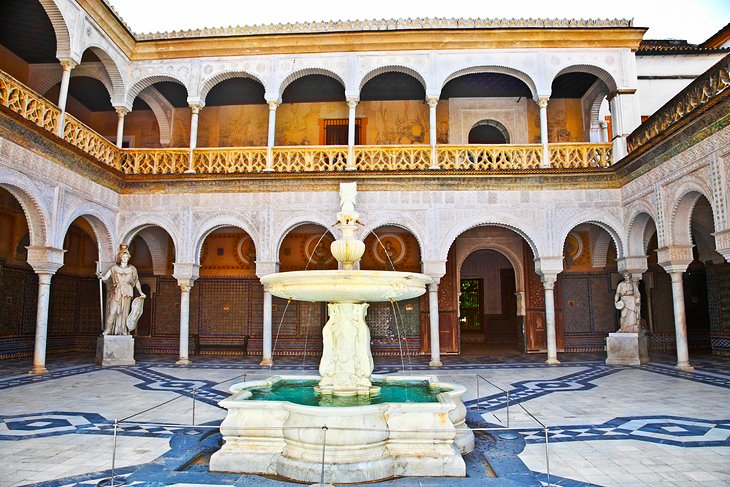
The Casa de Pilatos (Palace of the Governors of Andalusia) is a designated National Monument. This exquisite palace was once the private residence of the aristocratic Enríquez de Ribera family, including the Dukes of Alcalá.
Built in the 15th and 16th centuries, the Casa de Pilatos is believed to be a replica of Pilate's house in Jerusalem. The house features a variation of Mudéjar style, with Renaissance-era Plateresque details, as well as Baroque elements. Typical of Andalusian architecture, the building has a central patio adorned with azulejos (colorful ceramic tiles) and antique sculptures.
The Salón Dorado (Golden Room) is a beautiful room with faience decorations and an artesonado (coffered wood) ceiling. The main staircase and the private chapel are also noteworthy. A collection of ancient Roman sculptures is displayed throughout the house.
Tourists may take a self-guided tour of the Casa de Pilatos. The price of admission includes an audioguide.
Address: 1 Plaza de Pilatos, Seville
Museo Arqueológico de Sevilla
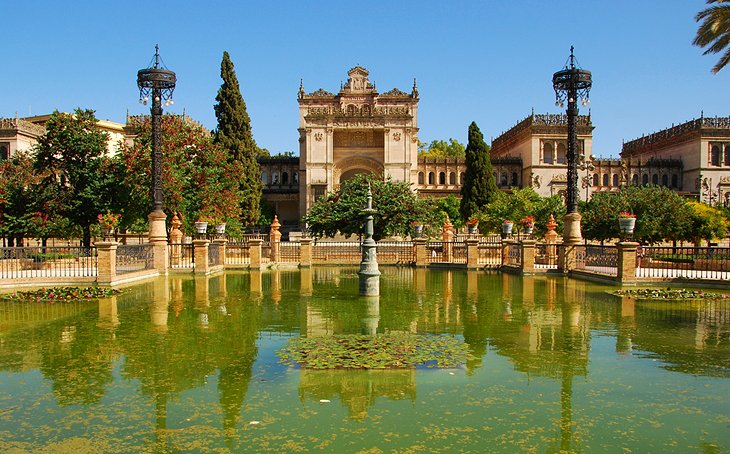
Located within the Parque de María Luisa, the Archaeological Museum of Seville occupies a Neo-Renaissance pavilion built for the Ibero-American Exposition of 1929.
The collection begins with the early Paleolithic period; continues with Phoenician, Greek, and Roman antiquities; and finishes with Moorish and Mudéjar items from the Middle Ages.
The ground floor displays artifacts discovered at the Itálica archaeological site (nine kilometers away) in the province of Seville. Among the highlights are the gold jewelry and a statue of Diana.
Another remarkable piece is the Carambolo Treasure from the Tartessian period, which is displayed in its own room on the first floor. This room contains a reproduction of the gold treasure and a shrine dedicated to Phoenician divinities.
Address: Plaza de América, Parque de María Luisa, Sevilla
Ayuntamiento de Sevilla (Town Hall)
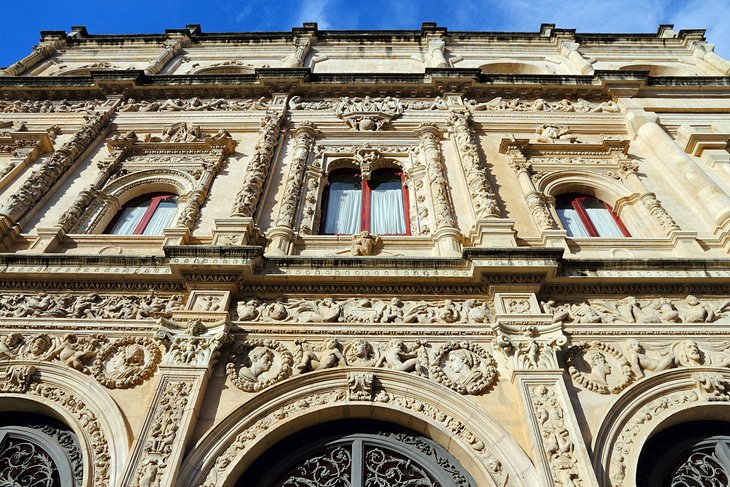
This impressive 15th-century town hall was designed in the Plateresque style by Diego de Riaño. The intricately carved reliefs on the southern facade depict figures from historical stories and mythology, as well as emblems of the storied founders of the city, Hercules and Caesar.
The building was renovated in the 19th century with a Neoclassical main facade that looks out onto the Plaza Nueva. A small archway connects the town hall building to the adjacent Franciscan monastery.
Tourists may make an appointment (advanced reservations are required) to visit the interior, which contains several important artistic works including a painting of the town's patron saints, Justa and Rufina.
Address: 1 Plaza Nueva, Seville
Palacio de la Condesa de Lebrija

The Palacio Lebrija is a lovely aristocratic Sevillian mansion of the 16th century. The palace was designed to impress, with its splendid mosaic floors, grand staircase leading up to the second floor and gorgeous artesonado ceilings. The walls are decorated with Arabic-style plateresque ornamentation, and the courtyard is filled with Andalusian plants.
The palace displays a collection of archaeological treasures, including Ancient Greek mosaics, glasses, vases, and sculptures. Other highlights include paintings by Joaquín Sorolla, the famous 19th-century Spanish painter (the "Master of Light") known for his vibrant sun-dappled scenes.
The Palacio Lebrija is open to the public for visits every day. Admission is free on Friday mornings.
Address: 8 Calle Cuna, Seville
Official site: https://palaciodelebrija.com/en/
Monasterio de Santa Paula
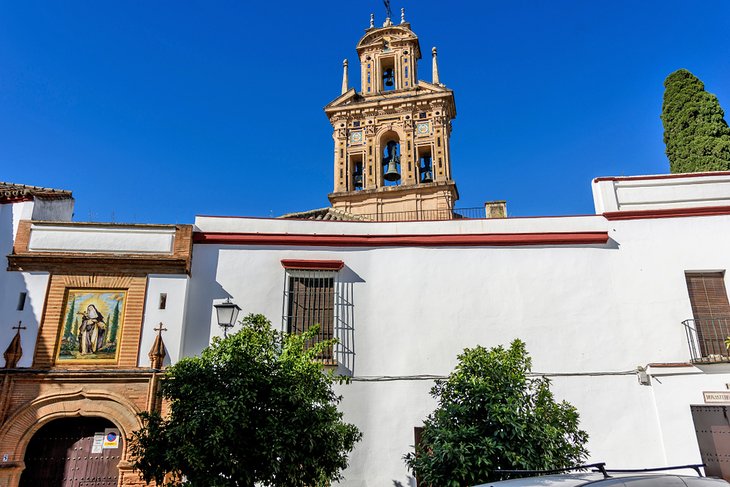
The Monasterio de Santa Paula was founded by Doña Ana de Santillán in 1473 for the Jerónimas nuns. For five centuries, this monastery has been devoted to divine worship and the study of Scripture.
Within the cloisters of the building, the monastery possesses an important art collection. Tourists can visit the monastery to discover its artistic heritage. Sometimes the nuns can also be found selling their handmade cakes and confections here.
Address: 11 Calle Santa Paula, Seville
Archivo General de Indias
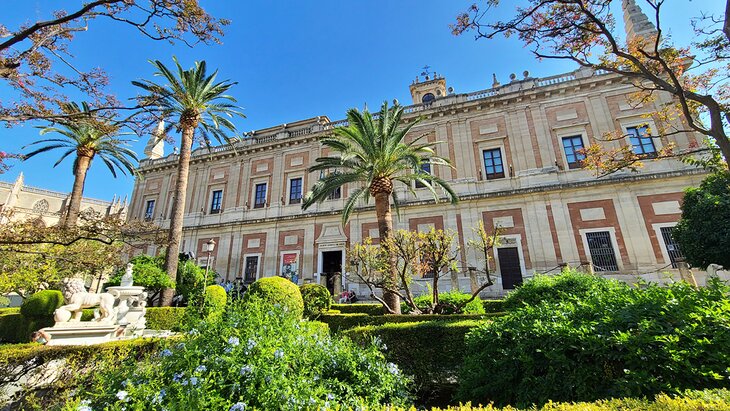
Across from the Alcázar is the 16th-century Casa Lonja de Mercaderes (merchants' exchange building), which houses the UNESCO-listed Archivo General de Indias, an archive of documents from Spain's colonial years in the New World.
The General Archive of the Indies was created by the Spanish government during the reign of Carlos III, for the purpose of the administration of overseas territories. Besides providing safekeeping for historic documents, the General Archive displays a small selection of documents and presents exhibits focused on Spain's Age of Exploration.
Address: 3 Avenida de la Constitución, Sevilla
Torre del Oro
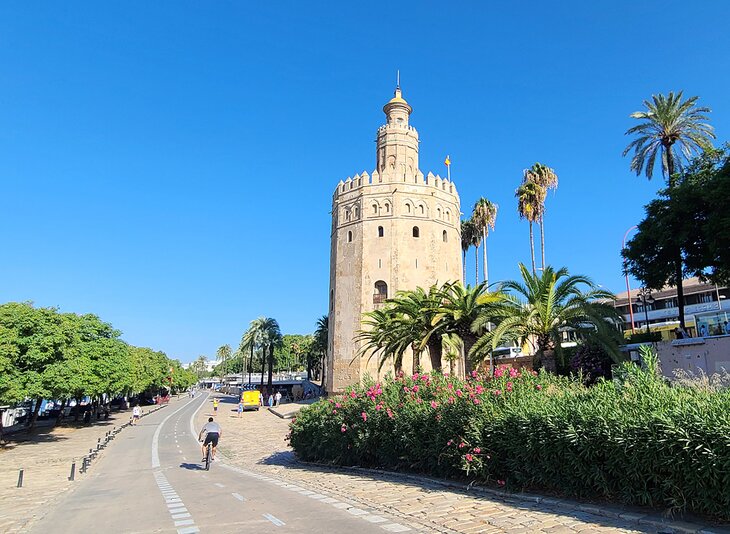
Built in 1220, this iconic tower was originally part of the city's defensive walls. The 36-meter-tall monument stands on the left bank of the Guadalquivir River and was designed as a watchtower to protect against invasions.
Golden-hued tiles once covered the tower, which explains its name: "Tower of Gold."
Today, the Torre del Oro houses the Museo Marítimo de Sevilla (Naval Museum), which contains a collection of old ship models, historic navigation charts, and other exhibits related to Spain's maritime heritage. The museum also features a terrace that affords panoramic vistas.
Address: Paseo de Cristóbal Colón, Sevilla
Metropol Parasol
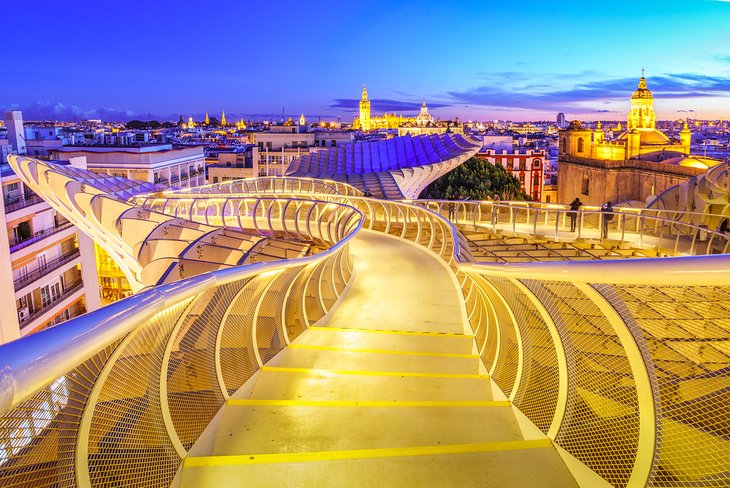
For amazing views of the Seville cityscape, head to the Metropol Parasol walkway and viewpoint. This unique structure created by the German architect Jürgen Mayer and inaugurated in 2011 is known as "Las Setas" ("The Mushrooms") because the shape resembles six large mushrooms.
The walkway and viewpoint are found on the top of the structure at 26 meters above the ground, which provides a wonderful perspective of the city's rooftops and landmarks.
At a lower level than the walkway, there is a tapas restaurant.
The basement of the structure contains the Antiquarium, an archaeological site. Visitors have a chance to see ruins from the ancient Roman, Visigoth, and Moorish eras.
Address: Plaza de la Encarnación, Sevilla
Seville's Riverfront
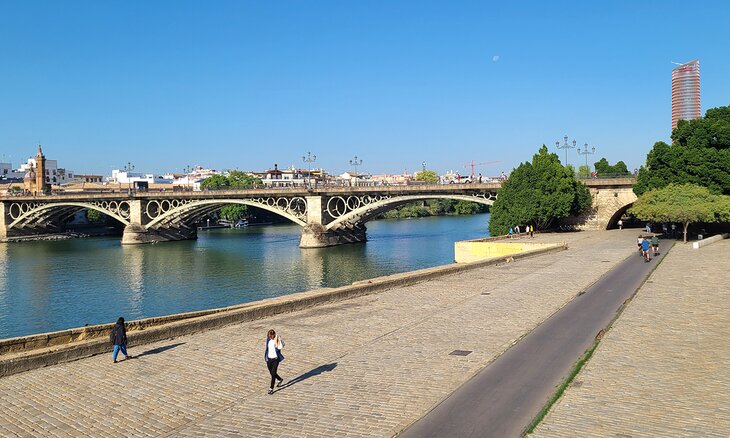
If you've had enough sightseeing and every church and old building is starting to look the same, an escape from the historical center is nearby. Seville's riverfront area is a special place with open spaces to walk, run, ride a bike, or even go stand up paddleboarding or rowing.
The main area runs right along the banks of the Guadalquivir River from the Punte de San Telmo past the Torre del Oro to the Puente del Cachorro. The entire area is set below the main roadway so it's quiet and peaceful with public artwork along the way.
Across the river are wonderful views of the colorful Barrio de Triana. After your riverfront stroll, cross one of the bridges and find a perfect patio all the while getting lost in the maze of alleyways.
Map of Tourist Attractions & Things to Do in Seville
More Related Articles on PlanetWare.com
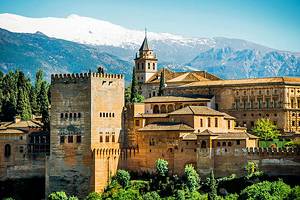
Exploring Andalusia: Once you've explored the top places to visit in Seville, you'll find plenty of other worthwhile destinations in Andalusia. It's only about a 90-minute drive to Córdoba, where you can see the magnificent UNESCO-listed La Mezquita (the Great Mosque) and wander the tangle of lanes in the enchanting Judería (old Jewish quarter), with its white-washed houses and flower-filled patios. Drive about three hours east from Seville to explore the highlights of Granada, including the majestic Alhambra, a UNESCO-listed complex of ornate palaces, a Moorish fortress, and luxuriant gardens.
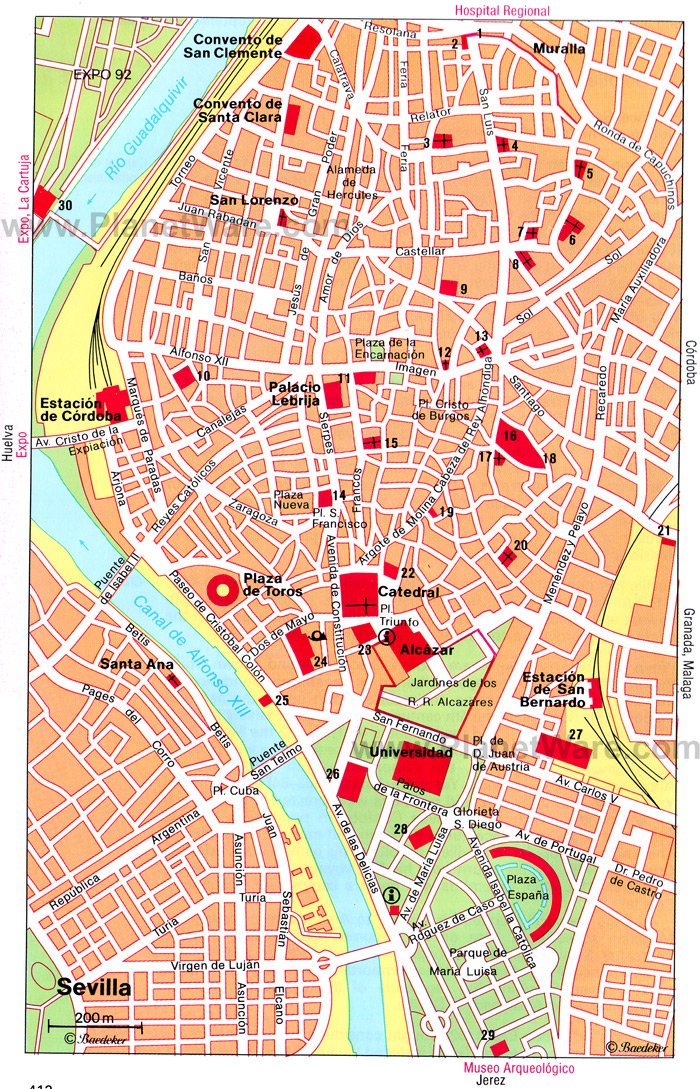
- (1) Puerto Macarena
- (2) San Gil
- (3) Omnium Sanctorum
- (4) Santa Marina
- (5) San Julián
- (6) Convento de Santa Paula
- (7) Santa Isabel
- (8) San Marcos
- (9) Casa de la Dueñas
- (10) Museo de Bellas Artes
- (11) Pabellón Sevillanos Illustres
- (12) San Pedro
- (13) Santa Catalina
- (14) Ayuntamiento
- (15) San Salvador
- (16) Convento de San Leandro
- (17) San lldefonso
- (18) Casa de Pilatos
- (19) Monolitos Romanos,
- (20) Santa Maria la Blanca
- (21) Acueducto
- (22) Palacio Arzobispal
- (23) Casa Lonja (Archivo de Indias)
- (24) Hospital de la Caridad
- (25) Torre del Oro
- (26) Palacio San Telmo
- (27) Estación de Autobuses
- (28) Teatro Lope de Vega
- (29) Museo de Artes y Costumbres Populares nos Illustres
- Alameda de Hércules and Vicinity
- Alcázar
- Barrio de Santa Cruz
- Basílica Macarena
- Cathedral
- Former Site of EXPO '92
- Museum of Contemporary Art
- Palacio Lebrija
- Plaza de España
- Plaza Nueva
- Plaza San Francisco
- Sagrario
- San Lorenzo
- Santa Ana
- Street of the Snakes


